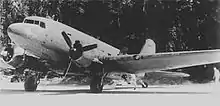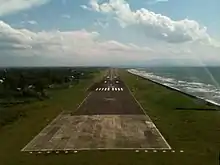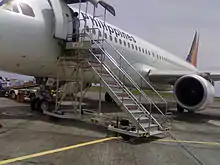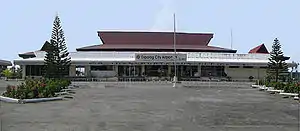Dipolog Airport
Dipolog Airport (Cebuano: Tugpahanan sa Dipolog) (IATA: DPL, ICAO: RPMG) is the main airport serving the general area of Dipolog, the capital city of Zamboanga del Norte, in the Philippines. The airport is one of the busiest in Mindanao, especially considering its classification. It is classified as a secondary airport by the Civil Aviation Authority of the Philippines (CAAP), a body of the Department of Transportation (DOTr) responsible for the operations of airports in the Philippines except the major international ones.
Dipolog Airport Tugpahanan sa Dipolog | |||||||||||
|---|---|---|---|---|---|---|---|---|---|---|---|
 Exterior of Dipolog Airport | |||||||||||
| Summary | |||||||||||
| Airport type | Public | ||||||||||
| Operator | Civil Aviation Authority of the Philippines | ||||||||||
| Serves | Dipolog | ||||||||||
| Location | Dipolog Airport Complex, Barangay Minaog, Dipolog City | ||||||||||
| Elevation AMSL | 4 m / 12 ft | ||||||||||
| Coordinates | 08°36′5″N 123°20′31″E | ||||||||||
| Map | |||||||||||
.svg.png.webp) DPL/RPMG Location in the Philippines | |||||||||||
| Runways | |||||||||||
| |||||||||||
| Statistics (2018) | |||||||||||
| |||||||||||
Source: Statistics from eFOI[1] | |||||||||||
In 2005, the airport handled 75,751 passengers. Its passenger traffic has grown at least 52% from year 2000 statistical figures with an average annual growth rate of around 10.4%.[2]
History

During the incumbency of Matias C. Ranillo Sr. as Governor of Zamboanga peninsula in 1937-1941, President Manuel Quezon and his daughters Zenaida and Aurora "Baby", were invited to inaugurate the opening of the first bridge linking Dipolog to nearby Dapitan in 1939. The bridge stands to this day as the Quezon Bridge.
The 600-meter macadam airstrip was opened in October 1941, a few months before the outbreak of World War II, by then-Vice President Sergio Osmeña and Chief of Staff Basilio Valdez. They inaugurated the airport on a flight on board a Douglas DC-2 of the Philippine Army Air Corps (PAAC). They were welcomed by Governor Matias C. Ranillo, Sr. but the entourage promptly proceeded to Dipolog Cathedral for a thanksgiving mass since the plane almost crashed at landing. Father Nicasio Yebes Patangan was the officiating priest.[3]
Development

The original terminal was made of composite wood material at the northern side of the runway near the Philippine Constabulary Camp, now Camp Hamac in Sicayab. During World War II, the field was overrun by rank grass. It was still used by Col. Hipolito Garma's guerrilla 105th Division, as a re-supply base for Wendell Fertig's guerrillas and as an emergency landing field.[4]:593–594 In October 1944, Governor Ranillo led the Dipolognons to clear the runway at the request of the Filipino guerrilla forces. By 8 March, four divisions of 16 Vought F4U Corsair US Marine fighter bombers and the 13th US Air Force established base as part of the Victor IV liberation plan. They covered the landing of the 41st Infantry Division in Zamboanga on D-day scheduled on 10 March.[4]:594 It was completely restored in 1947 with the construction of a longer runway and bigger terminal that was relocated to the eastern side of runway 20. A new access road was also constructed, complementing its facility.
Commercial operation by Philippine Airlines commenced in 1952 using a Douglas DC-3 aircraft for routes to and from Cebu City and Zamboanga City. Concreting and expansion of the runway was made in 1974 when a new taxiway and apron was built. A new terminal building was constructed in 1980, relocating the old terminal to where it stands to this day. A bigger parking area and new access road was opened with the new terminal. A control tower was added in 1991, and new runway lights were installed in 2004.

The airport's strategic location during World War II and the liberation of Zamboanga and Mindanao by American and Philippine Commonwealth Forces in 1945 prompted the national government to develop the field as an alternate to Zamboanga International Airport principally for national security reasons arising from natural and man-made emergencies. This was made apparent during the tumultuous period of the Muslim Rebellion in the early 1970s. Its infrastructure at that time was testament to its strategic importance.
Commercial traffic
The late 1980s saw a dramatic upsurge in foreign tourist arrival. Aerolift Philippines launched flights to Manila using a Beechcraft 1900-C aircraft in 1987.
The airport's commercial viability for growth was established as more flights were mounted by Philippine Airlines prompting the national government to introduce further development. The city government of Dipolog incorporated its growth potential in their development strategy plan.[5]
In 1992, after extending its runway by 500 meters and constructing a control tower, Dipolog Airport officially welcomed its first mid-size passenger jet, a Philippine Airlines Boeing 737-300. The same year, daily flights to Dumaguete were introduced by PAL using Short 360 aircraft but were dropped one year later.
In 2002, at least 25% of the passenger traffic bound for Dipolog Airport was composed of foreign tourists.[6]
In July 2006, Cebu Pacific launched non-stop service to Manila using an Airbus A319 with a seating capacity of 150 passengers.
In December 2006, it registered a maximum traffic of 330 daily passengers on several occasions based on the aircraft's available capacity serving the route with Philippine Airlines using the much bigger Boeing 737-400 with a seating capacity of 180 passengers.
The airport was expected to handle more than 150,000 passengers per year by 2009 or an average of 415 daily passengers, which is equivalent to three narrow-body aircraft flights or two flights using one wide-body and one narrow-body aircraft. During the incumbency of former Mayor Evelyn Uy, the City Government built a bridge and an access road to Barangay Barra cutting travel time to and from the City's Business District.
Future development
In 2018, the Department of Transportation (DOTr), through Secretary Arthur Tugade, planned to upgrade Dipolog Airport, and other local Philippine airports to handle evening flights.[7]
Airlines and destinations

Due to cancellation of flights following the COVID-19 pandemic, this list is no longer current and destinations are subject to change without prior notice.[8]
| Airlines | Destinations |
|---|---|
| Cebu Pacific | Manila |
| Cebu Pacific operated by Cebgo | Cebu |
| Philippine Airlines operated by PAL Express | Cebu,[9] Manila |
| Royhle Air Way | Charter: Dumaguete |
Structure
Terminal

The airport has one terminal and a 150-meter by 100-meter apron. The apron is capable of supporting two Airbus A320s and three large general aviation planes simultaneously. There are plans to expand the apron to accommodate bigger aircraft.
The terminal building, which originally had a capacity of 170 passengers, now has a seating capacity of 300 passengers due to new flights offered by Cebu Pacific. The terminal houses a metal detector and an X-ray machine for fast security check-in of passengers and their baggage.


Other structures
The airport has a modern control tower, a Category V fire station with four firetrucks and a new parking area complex near the Miss Universe Garden.
The new parking area would have a capacity of 100 vehicles when completed by the end of the year. The old parking area, which had a capacity of ninety vehicles, was partially converted into an security buffer zone, to address probable terrorist threats. Forty slots of the old parking area were made part of the new parking area. The city government is expanding again the parking area to accommodate the additional passenger traffic toward the vicinity of the Miss Universe Garden.
There is a mini-garden at the runway side of the terminal that contains a grotto.
The Civil Aviation Authority of the Philippines (CAAP) had put up the Heroes' Lounge for use of members and retirees of the Armed Forces of the Philippines and Philippine National Police, Armed Forces of the Philippines Medal of Valor and Philippine National Police Medal of Valor awardees, together with their families.[10] Dipolog Airport is one of the 24 airports in the Philippines to have a lounge dedicated to uniformed personnel and family members.
Master plan
Third Airport Development Project
The Dipolog Airport upgrading project was part of the 1997 Third Airport Development Project, a six-airport package that was supposed to be funded by the Asian Development Bank (ADB), the European Investment Bank (EIB), and the Philippine government with its counterpart fund. However, the Philippine government failed to provide on the counterpart fund for the $93 million project. The ADB loan was cancelled effective May 31, 2003.[11]
Scope of work
Designs for rehabilitation and upgrading were undertaken by COWI-NACO JV, with three local sub-consultants: TransAsia, Basic Team and COWI Philippines.[12] The scope of works included:
- Runway rehabilitation, extension and widening, and improvements of taxiways and aprons
- Grading of safety areas adjacent to the runway
- Construction of proper fencing between airside and landside areas
- Installation of x-ray equipment
- Upgrading of terminal and construction of new cargo building and other support facilities to increase service levels to handle forecast traffic for year 2010
- Installation of runway, approach lights and navigational aids in order to meet the international ICAO safety and security standards
- Expansion of utility facilities such as water supply and sewage treatment and
- Improvements of landside parking facilities.
As of April 2007, only items numbers one, two, five, six, and seven were not yet implemented due to huge budgetary requirements.
Southern Philippines Airport Development Project
DOTC repackaged the project in 2005 into the Southern Philippines Airport Development Project for funding. By 2006, ADB reconsidered Dipolog Airport as one of only three of the six airport projects to be considered for funding based on the request of airline companies operating on the approved facilities,[13] commercial viability, and passenger traffic.[14]
ADB Proposed Project Package
Components

- Runway extension, widening and asphalt overlay of the entire length
- 2,500 X 45 meters
- expansion of the taxiway, apron and terminal building
- apron capacity
- 1 wide-body stand
- 2 narrow-body aircraft stands
- 2 general aviation stands
- apron capacity
- construction of cargo building
- installation of approach lights ILS and radar equipment
References
- Civil Aviation Authority of the Philippines - Aerodrome Development & Management Service (15 April 2018). "Passenger Statistics Philippines". Republic of the Philippines - Freedom of Information Portal. Retrieved 27 April 2019.
- Aircraft, Passenger and Cargo Traffic-Dipolog Airport Archived September 29, 2007, at the Wayback Machine Accessed May 14, 2007
- "Archived copy". Archived from the original on 2007-09-30. Retrieved 2007-05-05.CS1 maint: archived copy as title (link)
- Smith, R.R., 2005, Triumph in the Philippines, Honolulu: University Press of the Pacific, ISBN 1410224953
- "Archived copy". Archived from the original on 2007-06-23. Retrieved 2007-05-05.CS1 maint: archived copy as title (link)
- "Archived copy". Archived from the original on 2007-06-10. Retrieved 2007-05-15.CS1 maint: archived copy as title (link)
- "20 PH airports can now handle evening flights". Archived from the original on 2018-11-07. Retrieved 2020-09-18.
- "Corona Virus Disease 2019 (COVID-19)". www.philippineairlines.com. Retrieved 2020-08-02.
- Liu, Jim. "Philippine Airlines W19 domestic network additions". Routesonline. Retrieved 17 October 2019.
- "Heroes' Lounge for cops, soldiers now open in 24 airports". Archived from the original on 2019-02-04. Retrieved 2020-09-17.
- "Archived copy". Archived from the original on 2007-10-20. Retrieved 2007-05-07.CS1 maint: archived copy as title (link)
- "Archived copy". The Manila Times. Archived from the original on 2007-04-16. Retrieved 2007-05-05.CS1 maint: archived copy as title (link)
- (PDF). 8 February 2006 https://web.archive.org/web/20060208223437/http://www.adb.org/Documents/PCRs/PHI/27142-PHI-PCR.pdf. Archived from the original on 8 February 2006. Missing or empty
|title=(help)CS1 maint: bot: original URL status unknown (link) - "Archived copy" (PDF). Archived from the original (PDF) on 2007-10-22. Retrieved 2007-05-05.CS1 maint: archived copy as title (link)
- "Archived copy". Archived from the original on 2007-06-13. Retrieved 2007-05-05.CS1 maint: archived copy as title (link)
- "Welcome to the ATRS Homepage" (PDF). www.atrsworld.org.
- "Archived copy". Archived from the original on 2007-09-29. Retrieved 2007-05-05.CS1 maint: archived copy as title (link)
External links
| Wikimedia Commons has media related to Dipolog Airport. |
- Zamboanga del Norte: Province Brief History
- Profile of Dipolog Airport by the Dipolog city government.
- Airport Investors Report, July 2006
- Zamboanga airport closed as aircraft blocks runway, by Bong Garcia, MINDANAO NEWS
- Govt readies new superbody to replace airport agencies, By Darwin G. Amojelar, MANILATIMES
- Philippine Government sets aside P6 B for mega region development, by Mike U. Crismundo,MANILA BULLETIN
- Super Region, Mindanao Committed Infrastructure Projects, by Jesus G. Dureza
- 2007 State of the Province Address by Governor Rolando G. Yebes.
- PAL Domestic Schedule 2007
- CEB Domestic Schedule 2007
- Third Airports Development Project